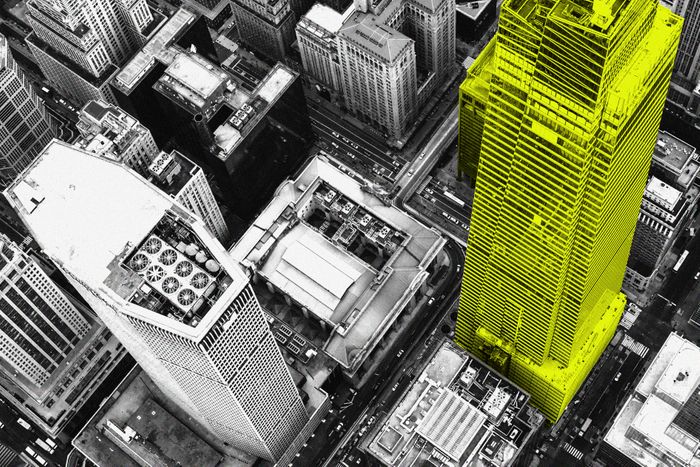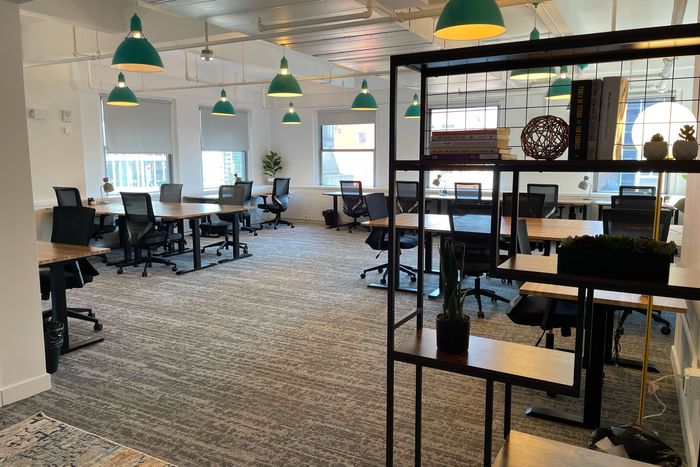
When office brokers talk about the “flight to quality” — the trend of brand-new trophy towers leasing up while older ones languish — One Vanderbilt is the kind of building they mean. The building, which opened in the fall of 2020, offers a full floor of lavish amenities — including shower rooms for business travelers coming in straight from the airport, expansive terraces, and a Daniel Boulud restaurant — is fully leased up, and bills itself as an “epitome of the 21st century workplace.” One Grand Central, a one-minute walk away on E. 42nd Street, is more like the epitome of the 20th. A neo-gothic tower completed in 1930, it has brass Deco detailing, a law library and a bronze statue of Lincoln in the lobby. Like many of the other buildings around Grand Central, it was nice enough in its day, and it’s not in bad shape now — it underwent an $85 million renovation in 2008 — but its amenities include a dated-looking conference center and Blue Bottle coffee. It seems like the type of older office building that Jeff Blau, the CEO of Related, was talking about when he recently told commercial property owners to sell off or, as he put it, “take what you can and run.” But One Grand Central is doing just fine — 98 percent leased, according to brokers.
In fact, most of the office buildings around Grand Central are doing well. At least, compared to the rest of Manhattan. (“Everywhere has a lot of vacancies right now,” says one broker with a sigh.) Since the start of 2022, Grand Central has leased the most space —225,000 square feet per month— of any submarket in Manhattan, according to commercial-real-estate firm CBRE. “Better” buildings in the tier of One Vanderbilt and 22 Vanderbilt have availability rates of 11.7 percent in the neighborhood — the paucity of superlative office towers accounts for the greater demand — compared to the 18.6 percent overall vacancy in Grand Central and 19.7 percent rate in Manhattan. Even the older, so-called commodity buildings in the neighborhood, which are most of them, are seeing solid demand. Grand Central has leased more commodity space than any other submarket in New York, nearly 3 million square feet since 2022.
Other transit hubs are also doing comparatively well — brokers and landlords mentioned Fulton Street in the Financial District, Union Square, and some of the buildings around Penn Station. But Grand Central, once the city’s preeminent office district, has so many advantages: an abundance of less-expensive office space, two commuter rails that feed directly into it (key for employees and clients who took advantage of remote work to move out of the city), and a pleasant neighborhood with a long-established network of restaurants, coffee shops, barbers, shoe-repair guys, and other businesses. So naturally suited is Grand Central to office life that the city targeted it for the Midtown East rezoning, which aimed to return it to its former business-district glory, replacing the older buildings with sleek new corporate skyscrapers.
As many of the buildings around Grand Central are older, prestige tenants tend to go to Park Avenue, where the modern skyscrapers with soaring ceilings, marble lobbies and floor-to-ceiling windows are. Temasek, the Singapore Sovereign Wealth Fund, recently signed a lease for a larger space at the Seagram building, which is 95 percent leased; 280 Park Avenue, where a giant Kaws sculpture in the lobby greets employees of blue-chip firms, is also doing well. On Park Avenue, the tenants are preponderantly firms with “capital holdings” in their name. But many companies don’t have the financial clout to rent Succession-caliber offices, and they’re driving the market for smaller, well-located, well-priced spaces, according to Kirill Azovtsev, executive managing director at Savills. The dated, older buildings around Grand Central, which are cheaper (especially the sublease space, which tends to rent for less and is pre-built), are ideal for them. As of this winter, Grand Central is also, finally, connected with the Long Island Railroad via East Side Access.
“One of the questions businesses are asking is ‘How am I going to get my employees back into the office?’” says Mike Slattery, director of tristate research at CBRE. “Part of that is providing light and air, more attractive amenities, and a really good location. On the other hand, if you can’t offer your workers all those bells and whistles, at least you can give them an office close to transit.”
Rock-climbing walls, Equinox-caliber gyms and rooftop bars are nice, but what workers really want, it seems, is an easier commute.
The bulk of new leases are not huge companies desperately trying to make a five-day return to the office happen and willing to throw down for the fanciest office space. “Deals involving big, publicly traded companies paying $100 per square foot are few and far between,” says Louis Puopolo, a commercial broker at Douglas Elliman. Most of the companies he works with are smaller firms seeking simpler things: light, air, location, more for their money. “They’re looking for an upgrade. A better commute, a nicer space. It’s not just the building; it’s the location,” he says. When tenants get off work, how many of them really to want linger around their offices for a yoga class or drinks at the rooftop bar?
Enthusiasm for the fun office of the mid-aughts was already fading out before COVID (thanks to the collapse of WeWork, Me Too, and growing social embarrassment over all those Ping-Pong tables and beanbag chairs). Coming off years of remote work, many people just want to get home, or at least to entertainments and companions of their choosing, after a full day at the office. “Sometimes I’m asked, ‘Should I put in an amenity floor to get tenants?’” says Puopolo, who tells building owners not to bother. “Who wants to go to a gym in their office building and work out next to their colleagues? This isn’t Miami.”
But an easier commute? That’s universally appealing. Serendipity Labs, a co-working and private office management company, is just now opening 41,000 square feet at 205 East 42nd Street. John Arenas, the chairman and CEO of Serendipity, says there’s enough demand to fill another 20,000 square feet if they had it. “Companies throughout the city are deciding to have work arrangements that require less space but are closer to transit,” says Arenas. Opening space in Grand Central had long been one of Serendipity’s goals, but it was too expensive before the pandemic.
For younger companies, the comparatively low rents in older buildings around Grand Central have made it feasible to rent office space, in some cases for the first time. Subleases offered by companies who want to get out from their contracts offer even cheaper, more short-term options (which, at a time when so many companies are trying to figure out their hybrid office needs, is considered favorable). Five Iron Golf, a six-year-old company that runs indoor golf clubs that pair simulators with restaurants and bars, subleased a 3,500-square-foot office at One Grand Central earlier this year, paying $32 per square foot. (The previous tenant fled in March 2020 and never came back; Five Iron took over not only its space but its furniture and outdated calendars.) That’s about half of what space in the building usually rents for. Even at the regular rate, rents in Grand Central average $67 per square foot, significantly less than the $83 per square foot Midtown average, according to CBRE.
“With prices coming down, you can justify having people in only three days a week,” says Jared Solomon, the co-founder and CEO of Five Iron. “It’s allowed us to find a nice balance of price, convenience and ability to work from home.”
Before moving to One Grand Central, Five Iron had a co-working space in Herald Square. But the rent was higher and the company’s employees were spread out across different floors. The new office isn’t glamorous — the ceilings are lowish and the view is of other buildings — but there’s some natural light and it’s literally across the street from Grand Central. “We never would have been able to afford a space like this before,” says Nora Dunnan, a co-founder and the CDO.
“There’s a lot of doom and gloom right now, and there’s going to be some pain as larger companies downsize and we see the fall-out of work from home,” says Solomon. “But there are still tons of companies that would love to rent space in New York. For a long time, the only businesses that could afford it were publicly traded companies and law firms.”
The company is also building out a Five Iron on the third floor of 101 Park, a newer office building around the corner, betting that the location will mean a steady stream of office workers coming in to play and hang out even in the era of hybrid work. The lunch crowds, at least, augur well: According to Dunnan, the taco shop on the corner had a line around the block on a recent Friday afternoon, no less.



